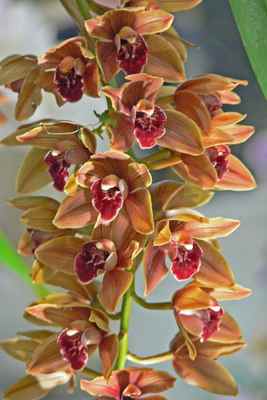By Sean Conway

If you haven't brought your houseplants back inside for the winter months, you'd better hurry. Some parts of the country have already had snow, never mind harmful frosts. In my garden in Rhode Island (hardiness zone 6b), I try to wait as long as I can before bringing my houseplants inside, but the time has come to start moving even my cool-loving plants back into the great indoors.
Some plants prefer to cool down gradually before being brought in for the winter. Cool-tolerant houseplants such as citrus, camellias and cymbidium orchids do better when allowed to experience the cool nights and warm days that fall offers. This gradual fluctuation in temperatures helps plants like my potted citrus collection acclimate to the cool sunny spot I keep the plants in over the winter months.
Without the luxury of a Floridian back yard, I am forced to winter my citrus trees in a sunny room that I maintain at 55 degrees all winter. They hold onto their colorful fruit all winter, and when they burst into bloom in late winter/early spring the clean, fresh smell of citrus blossoms permeates the house. Being kept at cooler temperatures also means they are ready to go back outside that much earlier in spring.
My cymbidiums are the last plants I bring inside every fall. This popular orchid can even tolerate light frosts without any signs of damage. Falling evening temperatures and declining daylight combine to cause the plant to form flower spikes that will bloom several months later.
Most houseplants, however, are best brought inside well before evening temperatures drop too low. Many houseplants will drop their leaves when exposed to the sudden changes in temperature when moved from outside to inside, especially combined with the lower humidity levels in most homes. This is a problem many people experience when they bring their ficus trees back indoors.
While almost all tropical houseplants benefit greatly from time spent outdoors during the summer months, they should be brought back inside before there is a great divergence between inside and outside temperatures. Remember that humidity levels tend to be lower inside our homes than outside, and your plants will grow much better if you increase humidity levels around them when you bring them in.
Typically it is best to repot plants during spring months just prior to the growing season. During the fall months when light levels begin to decrease, most plants either slow down or stop growing. However, if your plants have not been repotted in a while, or if you can see a build up of white residue caused by salt or mineral buildup on the edges of the soil surface, then repotting in the fall is warranted.
I grow several varieties of fancy-leafed geraniums that I save from year to year. Before I bring them in for the winter I cut them back, root prune them, refresh their potting soil and put them back into the same pots. Refreshing the soil allows the plants to put on a flush of new growth prior to the shortest days of winter when they will not grow much at all. The new fall growth is what I will use when taking cuttings of these beautiful plants next spring.
Repotting plants refreshes potting soil, which breaks down over time. As soil breaks down it reduces air space around your plants roots increasing the risk of root diseases. Repeated watering also leaches out minerals and nutrients, which can slow down a plant's growth and flower production.
Moving back indoors doesn't mean you have to leave your garden behind. Bringing houseplants back inside, or buying new ones, will keep you living green all winter long.
Available at Amazon.com:
Trowel and Error: Over 700 Tips, Remedies and Shortcuts for the Gardener
Cut Your Energy Bills Now: 150 Smart Ways to Save Money & Make Your Home More Comfortable & Green
It's Easy Being Green: A Handbook for Earth-Friendly Living
Copyright © Cultivating Life by Sean Conway. All rights reserved.
AUTOS | HOBBIES | EDUCATION | FAMILY | FASHION | FOOD & RECIPES | HOME DECOR | RELATIONSHIPS | PARENTING | PETS | TRAVEL | WOMEN
Home & Garden - Time to Bring the Garden Inside